Legendary 2-Channel Microphone Preamplifier with 3-Band Equalizers and Custom-Built Midas Transformers
Product Features
-
Two-channel microphone preamplifier with 3-band equalizers, based on the classic 1073 design
-
Class A, all discrete circuitry for highest signal integrity
-
Custom-built Midas input and output transformers
-
Versatile gain controls to handle various type of inputs including mic, line and instrument
-
Electronically controlled resistor-stepped 80 dB rotary gain switch for extreme precision and low noise
-
Tone function changes input transformer impedance for mic optimization
-
Dedicated Phase, Tone, Insert, Line, Instrument, and Phantom Power switches for each channel
-
Inductor-based switchable equalizers section with a passive third-order high-pass filter
-
Low-frequency boost/cut at 35, 60, 110 or 220 Hz
-
Mid-frequency boost/cut at 360, 700, 1600, 3200, 4800 or 7200 Hz
-
High-frequency boost/cut at 10, 12 or 16 kHz
-
5-position inductor-based high-pass filter, selectable for off, 50, 80, 160 or 300 Hz for each channel
-
Transformer-balanced inputs and outputs on XLR/combo connectors
-
High-precision 7-segment LED signal level meter for each channel
-
Rugged 2U rack mount chassis for durability in portable applications
-
Auto-ranging universal switchmode power supply

1273
Every so often an iconic piece of hardware takes the music industry by storm and transforms into a beloved fixture in studios worldwide. The 1073 was one such piece of gear. A mic preamp with a unique voice and rich sound, it became famous for shaping the sounds of many music generations, from the grit of ‘70s rock and roll, to the polished pop of the ‘80s. It was a staple in renowned studios like Abbey Road, Sound City, and Capitol Studios and influenced iconic tracks like Led Zeppelin’s “When the Levee Breaks” as well as The Who’s “Who’s Next.”
Today, we pay homage to that iconic studio cornerstone with the Behringer 1273, a two-channel microphone preamplifier, with built in EQ. The 1273 is more than just a remake. Developed with one of the original engineers, their valuable knowledge and experience ensures that the 1273 not only remains faithful to the original but is able to meet the demands of modern production.
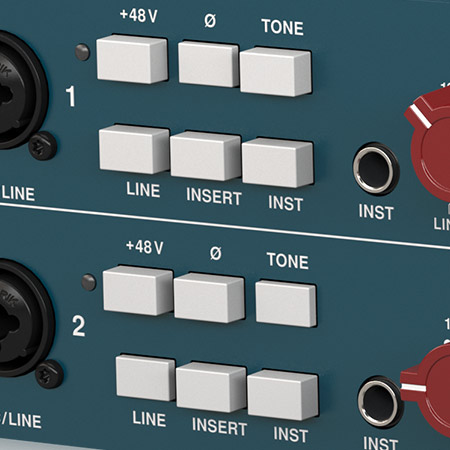
Versatile Operation
The 1273 is built around a Class A discrete circuit which ensures the highest signal integrity with minimal coloration. Each input and output stage is equipped with a high-quality, custom-built Midas transformer that’s great for maintaining signal clarity and integrity. The 1273 also has versatile gain controls for each channel for various input types such as mic, line and instrument, providing comprehensive control and flexibility for different recording scenarios. And if you’re switching between different mics like a dynamic to a ribbon, pressing the tone switch adjusts the transformer impedance for whatever mic is in use. Great for when your using vintage microphones.
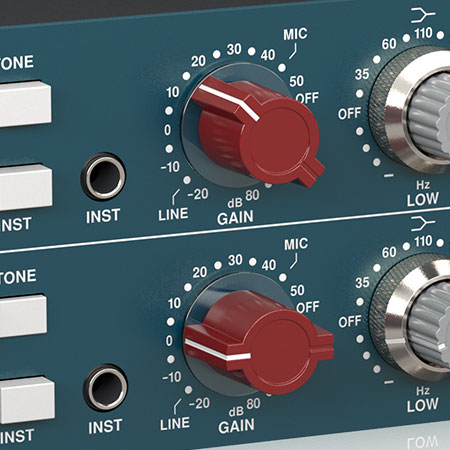
The First Steps
The 1273 includes an electronically controlled, resistor-stepped rotary gain switch that offers up to 80 dB of gain adjustment. This allows you to precisely set optimal input levels with the least amount of noise and is also great for recalling your settings consistently for every mix scenario.
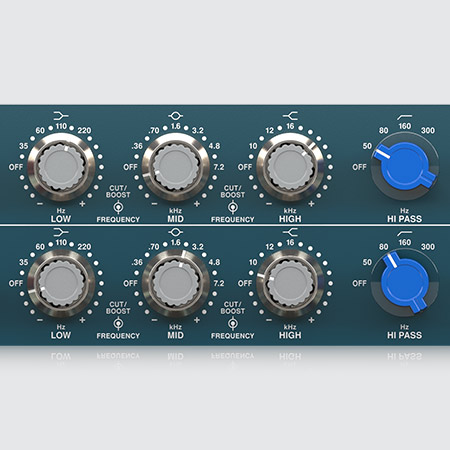
Precision Equalization
Taking a closer look at the 3-band EQ section, low frequencies can be set at 35, 60, 110 or 220 Hz; mid frequencies at 360, 700, 1600, 3200, 4800 or 7200 Hz; while highs can be set at 10, 12 or 16 kHz. This section and its inductor based rotary switches and are key to bringing out that lush, vintage sound in any mix. Combine this with the 5-position high-pass filter with selectable 50, 80, 160 or 300 Hz settings and you can get really creative, vocals can be made more intimate and present, guitars given a warm, woody sound, and bass tracks the thump and funk they deserve. Having fixed frequency settings and the ability to finely boost or cut specific frequencies is also very helpful in recreating configurations precisely.
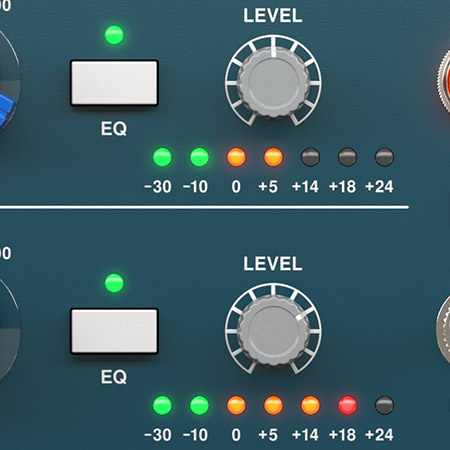
Additional Controls
The 1273 also allows you to compare your current mix to the original with the EQ switch that bypasses the gain and EQ settings on board so you can toggle between the mixed and unaltered track with ease. And for quick level monitoring, a 7-segment LED and level knob is available at the end of the signal chain.
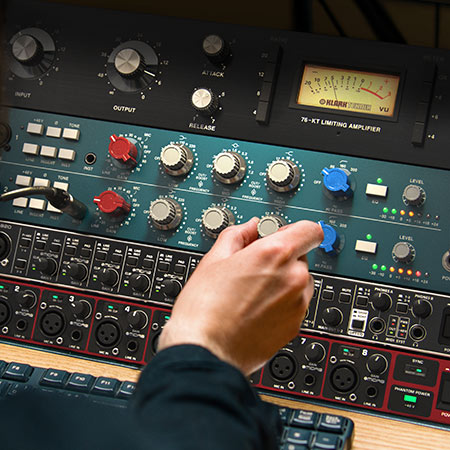
Ready for Your Studio!
The 2U rackmount chassis of the 1273 is extremely sturdy and while born for taking up just a few units of your precious rack real estate, it happily sits in a rack case if you sometimes record on location or want to use it for live sound applications where portability and mobility are key. Either way, 1273 is sure to be a perfect fit in your studio.
Specification
Audio Inputs
| Microphone |
Type: 2 x XLR, transformer balanced front Impedance: 300 Ω / 1200 Ω, balanced Max. input level: +19 dBu Gain: -20 to 80 dB Mic EIN @ 80 dB gain, 22 Hz to 22 kHz: -125 dBu Unweighted CMRR @ 60 dB gain: > 90 dB |
| Line |
Type: 2 x 1/4" TRS in combi socket, transformer balanced front Impedance: 10 kΩ, balanced Max. input level: +30 dBu (attenuated -34 dB) Gain: -20 to 80 dB CMRR @ 0 dB gain: > 80 dB |
| Instrument |
Type: 2 x 1/4" TRS, front, hi-Z via transformer Impedance: 600 kΩ, unbalanced Max. input level: +30 dBu (attenuated -20 dB) Gain: -20 to 80 dB Insert return: 2 x 1/4" TS |
Audio Outputs
| Type |
2 x XLR, 1/4" TRS, transformer balanced |
| Impedance |
< 80 Ω balanced |
| Max. output level |
+28 dBu |
| Insert send |
2 x 1/4" TS |
System Specifications
| Frequency response (microphone) |
20 Hz to 20 kHz, ±0.5 dB |
| Frequency response (line and instrument) |
20 Hz to 20 kHz, ±1 dB |
| Distortion (THD+N) |
<0.01% @ 1 kHz, +4 dBu |
| Noise |
< -83 dBu (20 Hz - 20 kHz unweighted) |
| Dynamic range |
> 102 dB typical (20 Hz to 20 kHz unweighted) |
| Circuit |
Class-A amplifiers, inductor based EQ |
EQ Section
| Hi pass filter |
50 / 80 / 160 / 300 Hz (18 dB/octave) |
| Low-band frequency range |
35 / 60 / 110 / 220 Hz |
| Boost / cut |
±15 dB |
| Mid-band frequency range |
360 / 700 / 1600 / 3200 / 4800 / 7200 Hz |
| Boost / cut |
±15 dB |
| High-band frequency range |
10 / 12 / 16 kHz |
| Boost / cut |
±15 dB |
Controls
| Buttons |
2 x 48 V phantom power |
| Controls |
2 x Gain - 20 to 80 dB |
| Switch |
On/off power switch |
1273
Legendary 2-Channel Microphone Preamplifier with 3-Band Equalizers and Custom-Built Midas Transformers
Product Features
-
Two-channel microphone preamplifier with 3-band equalizers, based on the classic 1073 design
-
Class A, all discrete circuitry for highest signal integrity
-
Custom-built Midas input and output transformers
-
Versatile gain controls to handle various type of inputs including mic, line and instrument
-
Electronically controlled resistor-stepped 80 dB rotary gain switch for extreme precision and low noise
-
Tone function changes input transformer impedance for mic optimization
-
Dedicated Phase, Tone, Insert, Line, Instrument, and Phantom Power switches for each channel
-
Inductor-based switchable equalizers section with a passive third-order high-pass filter
-
Low-frequency boost/cut at 35, 60, 110 or 220 Hz
-
Mid-frequency boost/cut at 360, 700, 1600, 3200, 4800 or 7200 Hz
-
High-frequency boost/cut at 10, 12 or 16 kHz
-
5-position inductor-based high-pass filter, selectable for off, 50, 80, 160 or 300 Hz for each channel
-
Transformer-balanced inputs and outputs on XLR/combo connectors
-
High-precision 7-segment LED signal level meter for each channel
-
Rugged 2U rack mount chassis for durability in portable applications
-
Auto-ranging universal switchmode power supply

1273
Every so often an iconic piece of hardware takes the music industry by storm and transforms into a beloved fixture in studios worldwide. The 1073 was one such piece of gear. A mic preamp with a unique voice and rich sound, it became famous for shaping the sounds of many music generations, from the grit of ‘70s rock and roll, to the polished pop of the ‘80s. It was a staple in renowned studios like Abbey Road, Sound City, and Capitol Studios and influenced iconic tracks like Led Zeppelin’s “When the Levee Breaks” as well as The Who’s “Who’s Next.”
Today, we pay homage to that iconic studio cornerstone with the Behringer 1273, a two-channel microphone preamplifier, with built in EQ. The 1273 is more than just a remake. Developed with one of the original engineers, their valuable knowledge and experience ensures that the 1273 not only remains faithful to the original but is able to meet the demands of modern production.

Versatile Operation
The 1273 is built around a Class A discrete circuit which ensures the highest signal integrity with minimal coloration. Each input and output stage is equipped with a high-quality, custom-built Midas transformer that’s great for maintaining signal clarity and integrity. The 1273 also has versatile gain controls for each channel for various input types such as mic, line and instrument, providing comprehensive control and flexibility for different recording scenarios. And if you’re switching between different mics like a dynamic to a ribbon, pressing the tone switch adjusts the transformer impedance for whatever mic is in use. Great for when your using vintage microphones.

The First Steps
The 1273 includes an electronically controlled, resistor-stepped rotary gain switch that offers up to 80 dB of gain adjustment. This allows you to precisely set optimal input levels with the least amount of noise and is also great for recalling your settings consistently for every mix scenario.

Precision Equalization
Taking a closer look at the 3-band EQ section, low frequencies can be set at 35, 60, 110 or 220 Hz; mid frequencies at 360, 700, 1600, 3200, 4800 or 7200 Hz; while highs can be set at 10, 12 or 16 kHz. This section and its inductor based rotary switches and are key to bringing out that lush, vintage sound in any mix. Combine this with the 5-position high-pass filter with selectable 50, 80, 160 or 300 Hz settings and you can get really creative, vocals can be made more intimate and present, guitars given a warm, woody sound, and bass tracks the thump and funk they deserve. Having fixed frequency settings and the ability to finely boost or cut specific frequencies is also very helpful in recreating configurations precisely.

Additional Controls
The 1273 also allows you to compare your current mix to the original with the EQ switch that bypasses the gain and EQ settings on board so you can toggle between the mixed and unaltered track with ease. And for quick level monitoring, a 7-segment LED and level knob is available at the end of the signal chain.

Ready for Your Studio!
The 2U rackmount chassis of the 1273 is extremely sturdy and while born for taking up just a few units of your precious rack real estate, it happily sits in a rack case if you sometimes record on location or want to use it for live sound applications where portability and mobility are key. Either way, 1273 is sure to be a perfect fit in your studio.
Specification
Audio Inputs
| Microphone |
Type: 2 x XLR, transformer balanced front Impedance: 300 Ω / 1200 Ω, balanced Max. input level: +19 dBu Gain: -20 to 80 dB Mic EIN @ 80 dB gain, 22 Hz to 22 kHz: -125 dBu Unweighted CMRR @ 60 dB gain: > 90 dB |
| Line |
Type: 2 x 1/4" TRS in combi socket, transformer balanced front Impedance: 10 kΩ, balanced Max. input level: +30 dBu (attenuated -34 dB) Gain: -20 to 80 dB CMRR @ 0 dB gain: > 80 dB |
| Instrument |
Type: 2 x 1/4" TRS, front, hi-Z via transformer Impedance: 600 kΩ, unbalanced Max. input level: +30 dBu (attenuated -20 dB) Gain: -20 to 80 dB Insert return: 2 x 1/4" TS |
Audio Outputs
| Type |
2 x XLR, 1/4" TRS, transformer balanced |
| Impedance |
< 80 Ω balanced |
| Max. output level |
+28 dBu |
| Insert send |
2 x 1/4" TS |
System Specifications
| Frequency response (microphone) |
20 Hz to 20 kHz, ±0.5 dB |
| Frequency response (line and instrument) |
20 Hz to 20 kHz, ±1 dB |
| Distortion (THD+N) |
<0.01% @ 1 kHz, +4 dBu |
| Noise |
< -83 dBu (20 Hz - 20 kHz unweighted) |
| Dynamic range |
> 102 dB typical (20 Hz to 20 kHz unweighted) |
| Circuit |
Class-A amplifiers, inductor based EQ |
EQ Section
| Hi pass filter |
50 / 80 / 160 / 300 Hz (18 dB/octave) |
| Low-band frequency range |
35 / 60 / 110 / 220 Hz |
| Boost / cut |
±15 dB |
| Mid-band frequency range |
360 / 700 / 1600 / 3200 / 4800 / 7200 Hz |
| Boost / cut |
±15 dB |
| High-band frequency range |
10 / 12 / 16 kHz |
| Boost / cut |
±15 dB |
Controls
| Buttons |
2 x 48 V phantom power |
| Controls |
2 x Gain - 20 to 80 dB |
| Switch |
On/off power switch |
Legendary 2-Channel Microphone Preamplifier with 3-Band Equalizers and Custom-Built Midas Transformers
Product Features
-
Two-channel microphone preamplifier with 3-band equalizers, based on the classic 1073 design
-
Class A, all discrete circuitry for highest signal integrity
-
Custom-built Midas input and output transformers
-
Versatile gain controls to handle various type of inputs including mic, line and instrument
-
Electronically controlled resistor-stepped 80 dB rotary gain switch for extreme precision and low noise
-
Tone function changes input transformer impedance for mic optimization
-
Dedicated Phase, Tone, Insert, Line, Instrument, and Phantom Power switches for each channel
-
Inductor-based switchable equalizers section with a passive third-order high-pass filter
-
Low-frequency boost/cut at 35, 60, 110 or 220 Hz
-
Mid-frequency boost/cut at 360, 700, 1600, 3200, 4800 or 7200 Hz
-
High-frequency boost/cut at 10, 12 or 16 kHz
-
5-position inductor-based high-pass filter, selectable for off, 50, 80, 160 or 300 Hz for each channel
-
Transformer-balanced inputs and outputs on XLR/combo connectors
-
High-precision 7-segment LED signal level meter for each channel
-
Rugged 2U rack mount chassis for durability in portable applications
-
Auto-ranging universal switchmode power supply

1273
Every so often an iconic piece of hardware takes the music industry by storm and transforms into a beloved fixture in studios worldwide. The 1073 was one such piece of gear. A mic preamp with a unique voice and rich sound, it became famous for shaping the sounds of many music generations, from the grit of ‘70s rock and roll, to the polished pop of the ‘80s. It was a staple in renowned studios like Abbey Road, Sound City, and Capitol Studios and influenced iconic tracks like Led Zeppelin’s “When the Levee Breaks” as well as The Who’s “Who’s Next.”
Today, we pay homage to that iconic studio cornerstone with the Behringer 1273, a two-channel microphone preamplifier, with built in EQ. The 1273 is more than just a remake. Developed with one of the original engineers, their valuable knowledge and experience ensures that the 1273 not only remains faithful to the original but is able to meet the demands of modern production.

Versatile Operation
The 1273 is built around a Class A discrete circuit which ensures the highest signal integrity with minimal coloration. Each input and output stage is equipped with a high-quality, custom-built Midas transformer that’s great for maintaining signal clarity and integrity. The 1273 also has versatile gain controls for each channel for various input types such as mic, line and instrument, providing comprehensive control and flexibility for different recording scenarios. And if you’re switching between different mics like a dynamic to a ribbon, pressing the tone switch adjusts the transformer impedance for whatever mic is in use. Great for when your using vintage microphones.

The First Steps
The 1273 includes an electronically controlled, resistor-stepped rotary gain switch that offers up to 80 dB of gain adjustment. This allows you to precisely set optimal input levels with the least amount of noise and is also great for recalling your settings consistently for every mix scenario.

Precision Equalization
Taking a closer look at the 3-band EQ section, low frequencies can be set at 35, 60, 110 or 220 Hz; mid frequencies at 360, 700, 1600, 3200, 4800 or 7200 Hz; while highs can be set at 10, 12 or 16 kHz. This section and its inductor based rotary switches and are key to bringing out that lush, vintage sound in any mix. Combine this with the 5-position high-pass filter with selectable 50, 80, 160 or 300 Hz settings and you can get really creative, vocals can be made more intimate and present, guitars given a warm, woody sound, and bass tracks the thump and funk they deserve. Having fixed frequency settings and the ability to finely boost or cut specific frequencies is also very helpful in recreating configurations precisely.

Additional Controls
The 1273 also allows you to compare your current mix to the original with the EQ switch that bypasses the gain and EQ settings on board so you can toggle between the mixed and unaltered track with ease. And for quick level monitoring, a 7-segment LED and level knob is available at the end of the signal chain.

Ready for Your Studio!
The 2U rackmount chassis of the 1273 is extremely sturdy and while born for taking up just a few units of your precious rack real estate, it happily sits in a rack case if you sometimes record on location or want to use it for live sound applications where portability and mobility are key. Either way, 1273 is sure to be a perfect fit in your studio.
Specification
Audio Inputs
| Microphone |
Type: 2 x XLR, transformer balanced front Impedance: 300 Ω / 1200 Ω, balanced Max. input level: +19 dBu Gain: -20 to 80 dB Mic EIN @ 80 dB gain, 22 Hz to 22 kHz: -125 dBu Unweighted CMRR @ 60 dB gain: > 90 dB |
| Line |
Type: 2 x 1/4" TRS in combi socket, transformer balanced front Impedance: 10 kΩ, balanced Max. input level: +30 dBu (attenuated -34 dB) Gain: -20 to 80 dB CMRR @ 0 dB gain: > 80 dB |
| Instrument |
Type: 2 x 1/4" TRS, front, hi-Z via transformer Impedance: 600 kΩ, unbalanced Max. input level: +30 dBu (attenuated -20 dB) Gain: -20 to 80 dB Insert return: 2 x 1/4" TS |
Audio Outputs
| Type |
2 x XLR, 1/4" TRS, transformer balanced |
| Impedance |
< 80 Ω balanced |
| Max. output level |
+28 dBu |
| Insert send |
2 x 1/4" TS |
System Specifications
| Frequency response (microphone) |
20 Hz to 20 kHz, ±0.5 dB |
| Frequency response (line and instrument) |
20 Hz to 20 kHz, ±1 dB |
| Distortion (THD+N) |
<0.01% @ 1 kHz, +4 dBu |
| Noise |
< -83 dBu (20 Hz - 20 kHz unweighted) |
| Dynamic range |
> 102 dB typical (20 Hz to 20 kHz unweighted) |
| Circuit |
Class-A amplifiers, inductor based EQ |
EQ Section
| Hi pass filter |
50 / 80 / 160 / 300 Hz (18 dB/octave) |
| Low-band frequency range |
35 / 60 / 110 / 220 Hz |
| Boost / cut |
±15 dB |
| Mid-band frequency range |
360 / 700 / 1600 / 3200 / 4800 / 7200 Hz |
| Boost / cut |
±15 dB |
| High-band frequency range |
10 / 12 / 16 kHz |
| Boost / cut |
±15 dB |
Controls
| Buttons |
2 x 48 V phantom power |
| Controls |
2 x Gain - 20 to 80 dB |
| Switch |
On/off power switch |
SHIPPING
Domestic delivery only
PRODUCT WARRANTY
For electric and electronic product only.
MAINTENANCE
Only products purchased from importers and dealer that has a warranty on the product.


